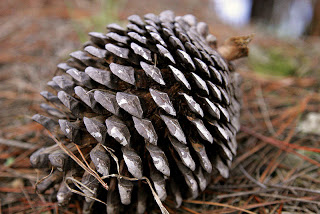The pineal scales are known for their ability to open and close in response to humidity levels in the air. In this study, the structural principle of the pine cone scales was applied using gelatin and iron oxide structures, which demonstrate the response to different humidity and temperature levels.

Smart scales
The pineal scales are known for their ability to open and close in response to humidity levels in the air. In this study, the structural principle of the pine cone scales was applied using gelatin and iron oxide structures, which demonstrate the response to different humidity and temperature levels.
A material with shape memory is a type of "smart" material, capable of changing shape in response to external stimulation. Researchers from the ETZ Institute of Technology in Zurich have created something a little different. Inspired by the pine cone, they developed a process that allows a wider range of materials to achieve a wider range of shapes.
The project, under the direction of Prof. Andre Stoddart, began with research into how the pine scales close when wet and open when dry. It turns out that each scale consists of two layers made of the same material. Stiff fibers in each of these layers are laid in one direction in one layer and in another direction in the other layer. In response to moisture, both layers swell, but the orientation of the fibers causes them to swell in different directions. The result is that one side of the scale is stretched lengthwise while the other side curves. As a result the scale is closed.
In the past we have already heard about the development of smart fabrics, based on the layered structure of the pine cone, which allows ventilation of the fabric in humid climate conditions. This research focuses on the application of the structural principle (the difference in the direction of the fibers between the two layers) for the development of new materials. The researchers took a material capable of swelling, gelatin, and added aluminum oxide particles to it as a fiber substitute. Pour the mixture into square molds. Because the particles were coated with iron oxide, they could be aligned in a certain direction using a magnetic field. Once one layer of the gelatin mixture was formed, they poured another layer on top of it. This layer was the same as the first, except that here the particles were aligned in a different direction.
Later this material was cut into strips, depending on the direction of the cut in relation to the orientation of the particles, the strips reacted differently to exposure to moisture. Other strips, made of a different polymer, responded to both humidity and temperature.
Prof. Stoddart claims that any substance that reacts to external stimulation can be used as a basis for these structures, when the particles can be made of different materials, since they are coated with iron oxide in any case. Among the possible applications for these materials are ceramic parts that shape themselves into a required shape, or biodegradable implants that adapt themselves to the required shape, and which become active only when they are placed in the correct part of the body.
Published by www.biomimicry.org.il

One response
By simple logic the pine cone will release its seeds when there is moisture,
That is, as suggested by the moisture, the scales should open
(do not quarantine as written),